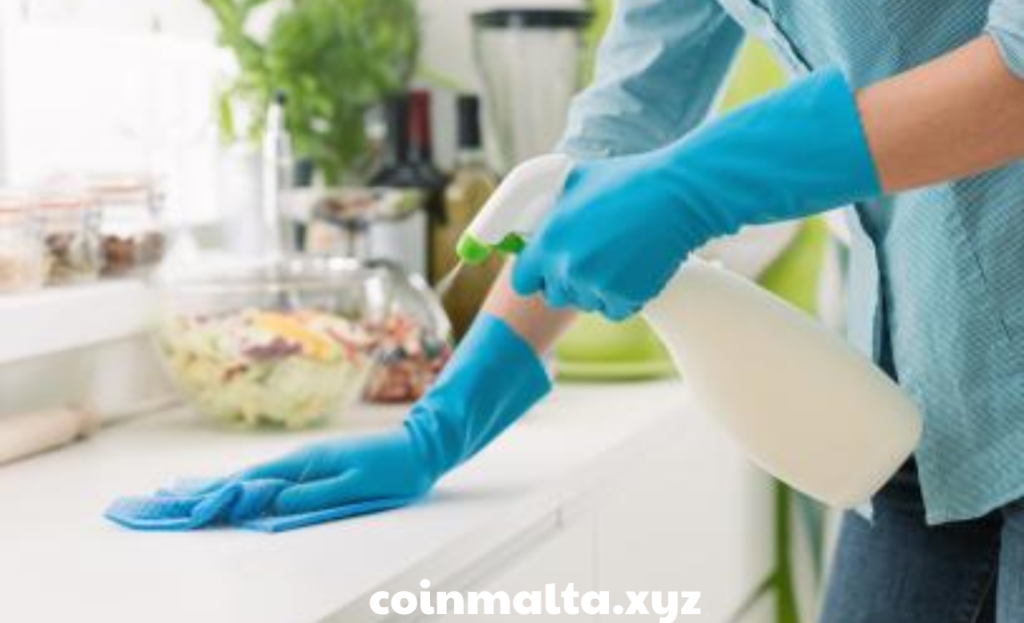Home Food Safety
Cleaning and Sanitizing Home Kitchens: Essential Tips for a Safe and Healthy Space
A clean and sanitized kitchen is crucial for ensuring food safety and maintaining a healthy home. Proper kitchen hygiene not only prevents the spread of harmful bacteria but also extends the life of your appliances and keeps your cooking environment pleasant. Whether you’re preparing meals for your family or hosting guests, knowing how to effectively clean and sanitize your kitchen is essential for protecting your health and avoiding contamination.
In this guide, we’ll explore the best practices for cleaning and sanitizing home kitchens, focusing on key areas like countertops, cutting boards, sinks, and appliances to ensure a safe and hygienic space.
1. Clean vs. Sanitize: What’s the Difference?
It’s important to understand the distinction between cleaning and sanitizing in the kitchen.
- Cleaning refers to removing dirt, food particles, and grease from surfaces. This is typically done using soap, water, and a scrubber.
- Sanitizing, on the other hand, involves reducing the number of bacteria and germs on surfaces to a safe level. Sanitizing is typically done after cleaning and requires disinfectants or sanitizing sprays that are specifically designed to kill germs.
Pro Tip:
- Clean First, Then Sanitize: Always clean surfaces before sanitizing to ensure that dirt and food particles are removed. Sanitizing on top of unclean surfaces reduces its effectiveness.
2. Best Practices for Cleaning and Sanitizing Countertops
Countertops are one of the most frequently used areas in the kitchen, making them a prime spot for bacteria buildup. Regularly cleaning and sanitizing your countertops can prevent cross-contamination and ensure a safe food preparation area.
Cleaning Tips:
- Use Mild Detergent: Wipe down countertops with warm water and a mild dish soap. Avoid harsh chemicals that can damage surfaces like granite or marble.
- Rinse Thoroughly: After cleaning, use a damp cloth to remove any soap residue.
Sanitizing Tips:
- Sanitizing Solution: Use a food-safe sanitizing spray or make your own solution by mixing 1 tablespoon of bleach with 1 gallon of water. Spray the surface and let it air dry or wipe it with a clean cloth.
- Daily Sanitizing: For busy kitchens, it’s a good idea to sanitize countertops at the end of each day, especially after preparing raw meat, poultry, or seafood.
Pro Tip:
- Consider Surface Type: Use cleaning products and sanitizers that are safe for your countertop material, whether it’s granite, laminate, or wood, to avoid damage.
3. Proper Cleaning and Sanitizing of Cutting Boards
Cutting boards can harbor bacteria from raw meat, vegetables, and other foods, making it critical to clean and sanitize them after each use.
Cleaning Tips:
- Hot Soapy Water: After each use, scrub cutting boards with hot water and dish soap. Pay special attention to grooves and cuts where bacteria can hide.
- Dishwasher Safe: If your cutting board is dishwasher safe (such as plastic or tempered glass boards), running it through the dishwasher can provide a thorough clean.
Sanitizing Tips:
- Vinegar or Bleach Solution: To sanitize, you can use white vinegar or a bleach solution (1 teaspoon of bleach per quart of water). Let the solution sit on the board for a few minutes before rinsing.
- Use Separate Boards: Use separate cutting boards for raw meats and fresh produce to avoid cross-contamination.
Pro Tip:
- Replace Over Time: Replace cutting boards once they develop deep cuts or cracks, as these are difficult to sanitize effectively and can harbor bacteria.
4. Cleaning and Sanitizing the Sink
Your kitchen sink is a breeding ground for bacteria, especially after washing raw foods or dirty dishes. Keeping your sink clean and sanitized is vital to avoid spreading germs to other kitchen areas.
Cleaning Tips:
- Daily Cleaning: Use a mild detergent and scrub the sink basin, faucet, and handles with a sponge or brush. Don’t forget to clean the sink drain and garbage disposal area.
- Deodorize the Disposal: Run lemon slices or a mixture of baking soda and vinegar through the disposal to keep it smelling fresh and free of bacteria.
Sanitizing Tips:
- Disinfect Weekly: Sanitize the sink with a bleach solution or use a kitchen disinfectant spray, making sure to cover all areas, including the drain.
- Air Dry or Towel Dry: Let the sink air dry after sanitizing, or use a clean towel to wipe it down.
Pro Tip:
- Use Sink Grids: Consider using a sink grid to keep dirty dishes off the sink’s surface, reducing the chance of bacteria transfer.
5. Maintaining Clean Kitchen Appliances
Your kitchen appliances, including the refrigerator, stove, microwave, and dishwasher, should also be cleaned and sanitized regularly to prevent the spread of germs and foodborne illness.
Refrigerator Cleaning Tips:
- Wipe Spills Immediately: Clean up spills in the refrigerator as soon as they happen to prevent bacteria growth.
- Monthly Cleaning: Remove all items from the fridge and wipe down shelves and drawers with warm soapy water or a baking soda solution to eliminate odors and bacteria.
Stove and Oven Cleaning Tips:
- Clean Spills Right Away: Wipe down the stove after cooking, especially if you’ve spilled food or liquids. Use a stovetop cleaner for stubborn stains.
- Sanitize Handles: Don’t forget to sanitize appliance handles and control knobs, as these are touched frequently.
Microwave Cleaning Tips:
- Steam Clean: Place a microwave-safe bowl of water and lemon slices inside and heat for a few minutes to loosen food residue. Wipe down the interior with a sponge.
- Sanitize: Use a kitchen disinfectant spray or a vinegar solution to sanitize the inside and outside of the microwave.
Pro Tip:
- Check Expiration Dates: While cleaning your refrigerator, check for expired items and toss them to prevent cross-contamination or foodborne illness.
6. Cleaning Sponges and Dishcloths
Your sponges and dishcloths are some of the most bacteria-prone items in your kitchen. Cleaning them regularly or replacing them frequently is essential to maintaining kitchen hygiene.
Cleaning Tips:
- Microwave Method: Wet your sponge and microwave it on high for 1-2 minutes to kill bacteria. Be sure the sponge is wet to avoid fire hazards.
- Dishwasher Cleaning: Place sponges in the dishwasher with a hot cycle to sanitize them.
- Replace Regularly: Replace sponges every 1-2 weeks, and dishcloths every few days to ensure cleanliness.
Pro Tip:
- Air Dry: Always allow sponges and dishcloths to dry completely between uses, as bacteria thrive in moist environments.
Conclusion
Keeping your kitchen clean and sanitized is essential for maintaining a healthy home and preventing the spread of germs and bacteria. By following these best practices for cleaning and sanitizing home kitchens, you can create a safe and hygienic environment that supports food safety and overall well-being. From countertops to appliances, ensuring that each surface and tool is properly cleaned will give you peace of mind while preparing meals for your family and guests.

